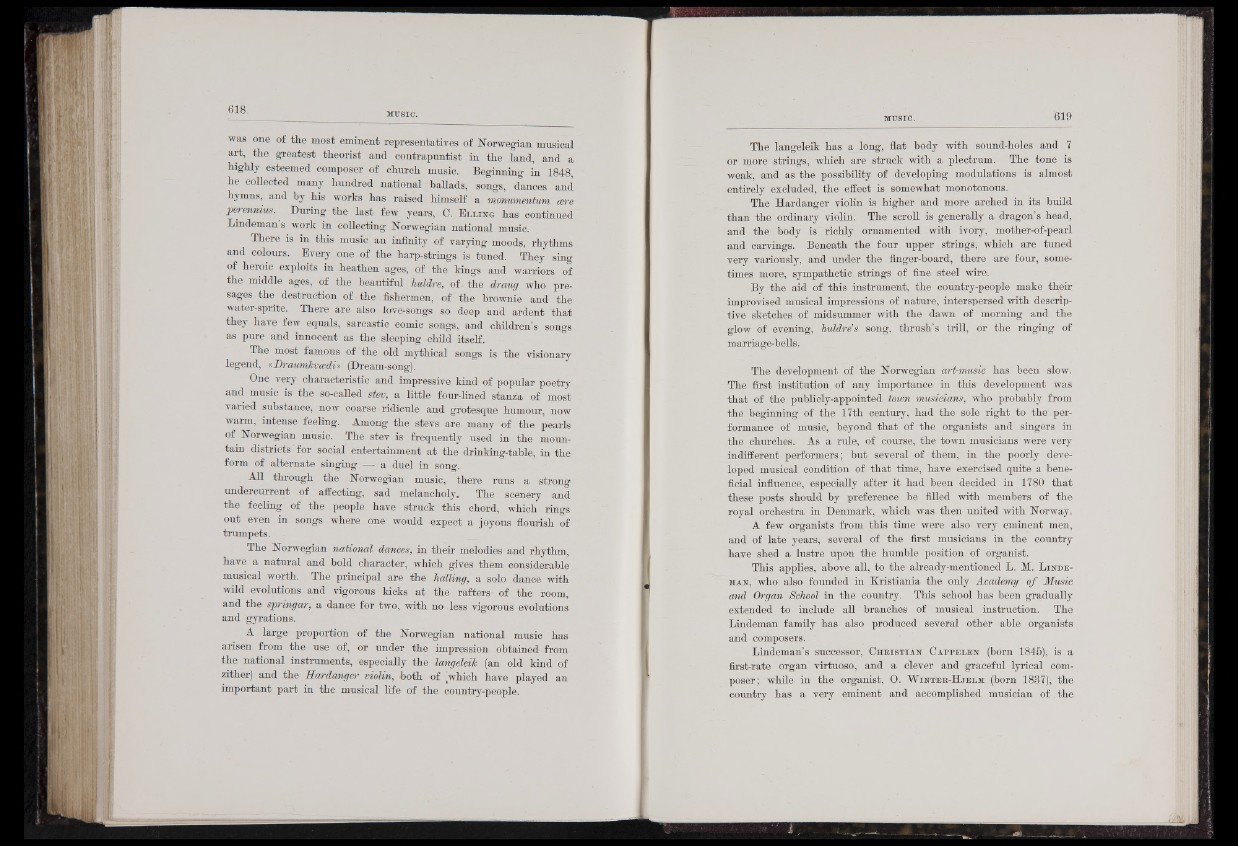
was one of the most eminent representatives of Norwegian musical
art, the greatest theorist and contrapuntist in the land, and a
highly esteemed composer of church music. Beginning in 1848,
he collected many hundred national ballads, songs, dances and
hymns, and by his works has raised himself a mommmtum cere
perennius. During the last few years, C . E l i i n g has continued
Lindeman s work in collecting Norwegian national music.
There is in this music an infinity of varying moods, rhythms
and colours. Every one of the harp-strings is tuned. They sing
of heroic exploits in heathen ages, of the kings and warriors of
the middle ages, of the beautiful huldre, of. the draug who presages
the destruction of the fishermen, of the brownie and the
water-sprite. There are also iove-songs so deep and ardent that
they have few equals, sarcastic comic songs, and children’s songs
as pure and innocent as the sleeping child itself.
The most famous of the old mythical songs is the visionary
legend, «Draumkvcedi» (Dream-song).
One very characteristic and impressive kind of popular poetry
and music is the sp-called stev, a little four-lined stanza of most
varied substance, now coarse ridicule and grotesque humour, now
warm, intense feeling. Among the stevs are. many of the pearls
of Norwegian music. The stev is frequently used in the mountain
districts'for social entertainment at the drinking-table, in the
form of alternate singing - I a duel in song.
All through the Norwegian music, there runs a strong
undercurrent of affecting, sad melancholy. The scenery and
the feeling of the people have struck this chord, which rings
out even in songs where one would expect a joyous flourish of
trumpets.
The Norwegian national dances, in their melodies and rhythm,
have a natural and bold character, which gives them considerable
musical worth. The principal are the hailing, a solo dance with
wild evolutions and vigorous kicks at the rafters- of the room,
and the springar, a dance for two, with no less vigorous evolutions
and gyrations.
A large proportion of the Norwegian national music has
arisen from the use of, or under the impression obtained from
the national instruments, especially the langeleik (an old kind of
zither) and the Hardanger violin, both of [which have played an
important part in the musical life of the country-people.
The langeleik has a long, flat body with sound-holes and 7
or more strings, which are struck with a plectrum. The tone is
weak, and as the possibility of developing modulations is almost
entirely excluded, the effect is somewhat monotonous.
The Hardanger violin is higher and more arched in its build
than the ordinary violin. The scroll is generally a dragon’s head,
and the body is richly ornamented with ivory, mother-of-pearl
and carvings. Beneath the four upper strings, which are tuned
very variously, and under the finger-board, there are four, sometimes
more, sympathetic strings of fine steel wire.
By the aid of this instrument, the country-people make their
improvised musical impressions of nature, interspersed with descriptive
sketches of midsummer with the dawn of morning and the
glow of evening, huldre’s song, thrush’s trill, or the ringing of
marriage-bells.
The development of the Norwegian art-musie has been slow.
The first institution of any importance in this development was
that of the publicly-appointed town musicians, who probably from
the beginning of the 17th century, had the sole right to the performance
of music, beyond that of the organists and singers in
the churches. As a rule, of course, the town musicians were very
indifferent performers; but several of them, in the poorly developed
musical condition of that time, have exercised quite a beneficial
influence, especially after it had been decided in 1780 that
these posts should by preference be filled with members of the
royal orchestra in Denmark, which was then united with Norway,
A few organists from this time were also very eminent men,
and of late years, several of the first musicians in the country
have shed a lustre upon the humble position of organist.
This applies, above all, to the already-mentioned L. M. Litob-
m a h , who also founded in Kristiania the only Academy of Music
and Organ School in the country. This school has been gradually
extended to include all branches of musical instruction. The
Lindeman family has also produced several other able organists
and composers.
Lindeman’s successor, C h r i s t i a n C a p p e l e n (born 1845), is a
first-rate organ virtuoso, and a clever and graceful lyrical composer;
while in the organist, O. Wi n t e r - H j e l m (born 1837), the
country has a very eminent and accomplished musician of the